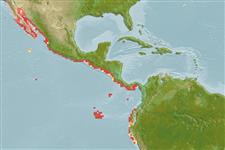Environment: milieu / climate zone / depth range / distribution range
Écologie
marin; saumâtre démersal; profondeur 0 - 60 m (Ref. 9342). Subtropical; 34°N - 9°S, 118°W - 79°W (Ref. 5222)
Eastern Central Pacific: San Francisco Bay, California, USA to Peru and the Galapagos Islands.
Taille / Poids / Âge
Maturity: Lm ? range ? - ? cm
Max length : 150 cm TL mâle / non sexé; (Ref. 5222); poids max. publié: 91.0 kg (Ref. 2850)
Épines dorsales (Total): 11; Rayons mous dorsaux (Total): 15-16; Épines anales 3; Rayons mous anaux: 10 - 11. Distinguished by the following characteristics: two color patterns, first is brown blotched pattern, grey or greyish green with oblong dark blotches dorsally, forming an irregular maze-like, pale reticulum, second is plain colored pattern is uniform greyish brown, darker fins and edged with white; depth of body contained 2.9-3.1 times in SL; head length 2.6-2.8 times in SL; angular preopercle, with distinct serrate lobe at angle; posterior nostrils notably larger than anterior nostrils (Ref. 89707).
Occurs from mangrove area to over hard bottom of the continental shelf and the slope (Ref. 11035). According to Thomson et al. (1979, Ref. 6852), this species prefers mangrove estuaries. Adults and juveniles occur in shallow water with adults found to depths of 60 m.
Life cycle and mating behavior
Maturité | Reproduction | Frai | Œufs | Fécondité | Larves
Heemstra, P.C. and J.E. Randall, 1993. FAO Species Catalogue. Vol. 16. Groupers of the world (family Serranidae, subfamily Epinephelinae). An annotated and illustrated catalogue of the grouper, rockcod, hind, coral grouper and lyretail species known to date. Rome: FAO. FAO Fish. Synop. 125(16):382 p. (Ref. 5222)
Statut dans la liste rouge de l'IUCN (Ref. 130435)
Menace pour l'homme
Harmless
Utilisations par l'homme
Pêcheries: intérêt commercial mineur; pêche sportive: oui
Plus d'informations
Noms communsSynonymesMétabolismePrédateursÉcotoxicologieReproductionMaturitéFraiRassemblement de ponteFéconditéŒufsDéveloppement de l'œuf
RéférencesAquacultureProfil d'aquacultureSouchesGénétiqueElectrophoresesHéritabilitéPathologiesTraitementNutrientsMass conversion
Outils
Articles particuliers
Télécharger en XML
Sources Internet
Estimates based on models
Preferred temperature (Ref.
123201): 19.5 - 28.6, mean 24.6 °C (based on 78 cells).
Phylogenetic diversity index (Ref.
82804): PD
50 = 0.5000 [Uniqueness, from 0.5 = low to 2.0 = high].
Bayesian length-weight: a=0.00933 (0.00429 - 0.02028), b=3.04 (2.87 - 3.21), in cm total length, based on LWR estimates for this Genus-body shape (Ref.
93245).
Niveau trophique (Ref.
69278): 4.5 ±0.8 se; based on size and trophs of closest relatives
Résilience (Ref.
120179): Faible, temps minimum de doublement de population : 4,5 à 14 années (Musick et al. 2000 (Ref.
36717)).
Fishing Vulnerability (Ref.
59153): Very high vulnerability (90 of 100).
Climate Vulnerability (Ref.
125649): Very high vulnerability (85 of 100).
Nutrients (Ref.
124155): Calcium = 33.8 [13.6, 69.2] mg/100g; Iron = 0.768 [0.417, 1.456] mg/100g; Protein = 18.9 [17.0, 20.6] %; Omega3 = 0.319 [0.193, 0.557] g/100g; Selenium = 30 [15, 61] μg/100g; VitaminA = 14.1 [4.3, 55.2] μg/100g; Zinc = 0.561 [0.392, 0.838] mg/100g (wet weight);
